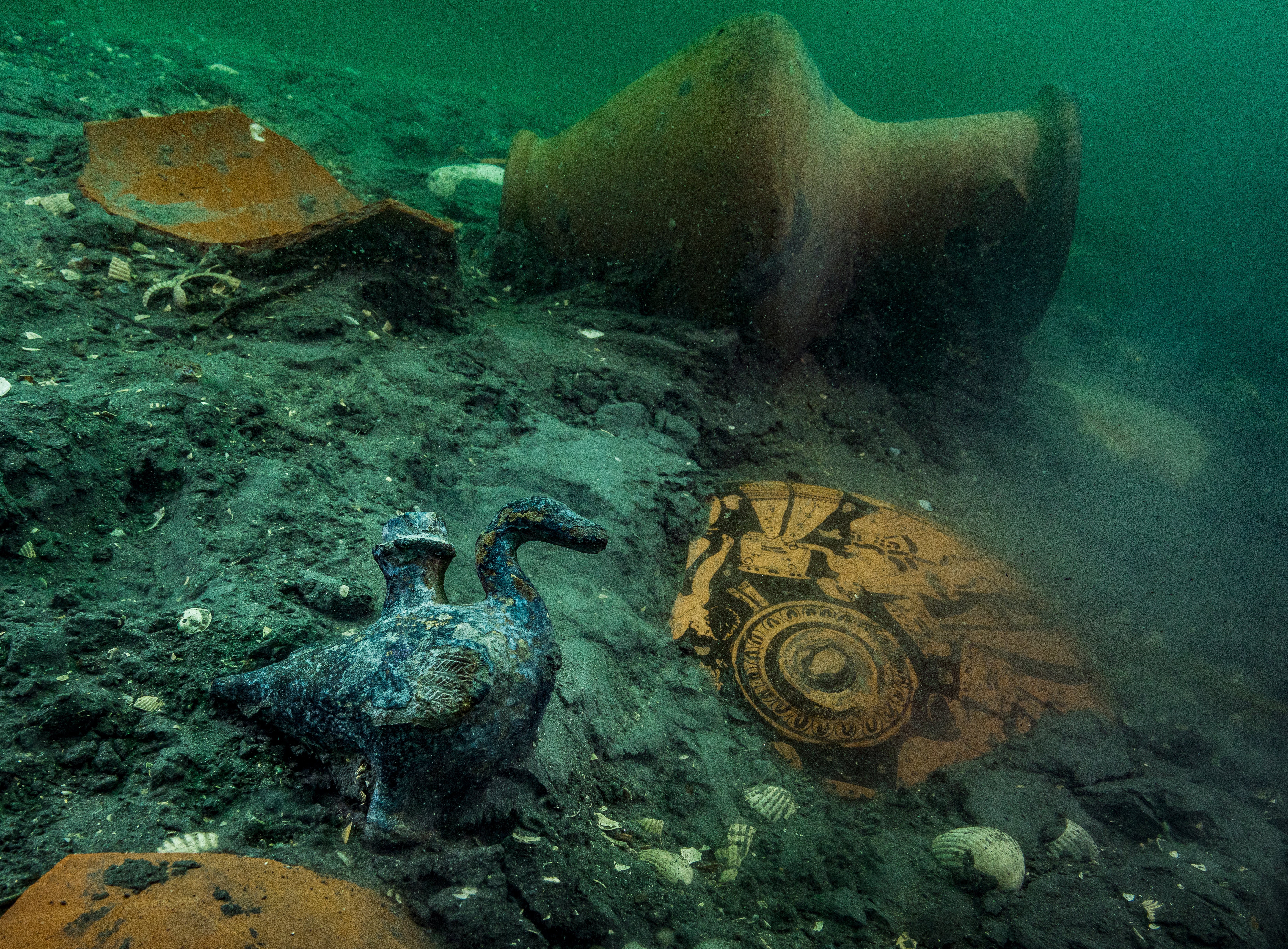The Day the Sea Spoke Again
Off Egypt’s northern coast, beneath the shimmering blue of Abu Qir Bay, divers move slowly through a ghostly silence. They are not looking for shipwrecks or coral reefs — they are tracing the streets of a lost kingdom.
For centuries, the ancient city of Thonis-Heracleion — once Egypt’s greatest Mediterranean port — was thought to be a myth. Now, two decades after its rediscovery, the sea continues to yield secrets once buried by tragedy and time.
In 2025, new finds have stunned archaeologists: a gold-inlaid ceremonial dagger, fragments of a sunken temple, and an underwater necropolis lined with statues of gods half-swallowed by sand. Together, they rewrite what we thought we knew about Egypt’s “Atlantis.”
The Rise of a Maritime Giant

Long before Alexandria stole the spotlight, Heracleion — known to Egyptians as Thonis — ruled the Nile Delta’s western mouth. It was where pharaohs met the sea, where Greek merchants brought olive oil and silver, and where Egyptian priests blessed their cargo in the temple of Amun-Gereb, the city’s beating heart.
The city thrived between the 6th and 4th centuries BC, serving as Egypt’s customs gateway for Mediterranean trade. Here, Greek and Egyptian cultures merged: statues of Heracles stood beside those of Isis; Greek amphorae lay beside papyrus scrolls; languages intertwined on temple walls.
Ancient chroniclers like Herodotus and Strabo mentioned a city by this name — a place of rituals, riches, and storms. But when it vanished, most assumed the stories were poetic invention.
The Great Sinking

Around 220 B.C., a series of catastrophic earthquakes shook the Nile Delta. Scholars believe the land beneath Heracleion, built on fragile silt, liquefied. Entire temples crumbled; docks slid into the sea; and within hours, the city was swallowed by the waves.
For two thousand years, Heracleion slept beneath the mud — undisturbed, untouched, unseen.
It wasn’t until the year 2000 that Franck Goddio, a French marine archaeologist, made a discovery that would electrify the world: enormous granite statues, half-buried in sediment, resting 30 feet beneath the water’s surface. “It was like walking into a dream,” he said. “The sea had preserved a civilization.”
2025: The New Treasures
This year’s expedition, led by the European Institute for Underwater Archaeology (IEASM), revealed an entire sanctuary complex previously unknown — including an altar room with gold amulets, silver ritual instruments, and the remains of an ancient warship crushed beneath a collapsed column.
Among the findings:
-
A gold-inlaid dagger, its blade still sharp, believed to have belonged to a temple guard.
-
Bronze coins minted under King Ptolemy II — proving Heracleion’s survival well into the Greek era.
-
Ceremonial jars used for libations to Isis and Osiris, recovered intact.
-
Fragments of colossal statues once towering above the temple’s gate — now resting face-down in the silt.
One diver described the sight as “entering a cathedral of stone and silence — except the saints are gods, and the altar is the sea.”
A City Between Worlds
What makes Heracleion unique is not just its preservation — it’s what it reveals about Egypt’s connection to the wider world.
The city was the first contact point for Greek traders arriving in the Nile Delta. Archaeologists found Greek inscriptions invoking Heracles and Egyptian ones honoring Amun, side by side. “It was a crossroads of faith,” says Dr. Hanan Abdel Rahman of Alexandria University. “Where the Greek gods met the Egyptian ones — and both were worshipped.”
The finds also show how the Ptolemies — Greek rulers who inherited Egypt after Alexander the Great — blended cultures to maintain legitimacy. Coins, pottery, and art from Heracleion show the seamless fusion of two civilizations that defined the Mediterranean for centuries.
The Science Behind the Recovery
Mapping Heracleion’s ruins is an extraordinary technological challenge. Using sub-bottom profilers, magnetometers, and 3D sonar, Goddio’s team builds digital maps of the seabed, revealing canals, houses, and shrines hidden beneath layers of mud.
The underwater silt acts like a natural time capsule. “Organic material that would have decayed on land is still here,” explains Goddio. “We’ve found papyrus fragments, wooden anchors, even rope.”
Some objects are lifted carefully to the surface; others are left in situ to avoid damage. Every artifact is desalinated for months before it can be displayed — a slow resurrection of a drowned civilization.
Echoes of Rituals and Power
At the heart of the new discoveries lies the Temple of Amun-Gereb, where pharaohs were once crowned. Ancient texts suggest that before a new ruler could ascend the throne, he had to travel by boat to Heracleion and offer tribute to the god of creation.
Inside the ruins, archaeologists found ceremonial platforms and votive offerings — including gold scarabs, miniature boats, and incense burners — suggesting intense religious activity.
Perhaps the most enigmatic find: a silver mirror engraved with the symbol of Isis, goddess of fertility and rebirth. The mirror, astonishingly uncorroded, reflects not just faces, but the enduring power of myth — that what was lost can rise again.
Lessons from the Abyss
Heracleion’s rediscovery has become more than an archaeological triumph; it’s a warning from history.
The same geological shifts that sank the city — rising seas, unstable deltas, human overbuilding — mirror the environmental crises of today. “Heracleion reminds us that civilizations can vanish not by war, but by water,” says oceanographer Dr. Jean-Pierre Arnaud. “It is both a memory and a prophecy.”
Egypt’s coastline is once again under threat from rising sea levels. In a poetic twist, the modern world may face the same peril that consumed its ancient past.
From Myth to Museum
Many of Heracleion’s treasures are now housed in the Egyptian Museum of Alexandria and the Hilti Foundation’s traveling exhibition, “Sunken Cities: Egypt’s Lost Worlds.” Visitors stand before statues once buried under centuries of saltwater — gods reborn from darkness.
But Goddio insists that Heracleion still holds more secrets. “We’ve uncovered barely 10% of the site,” he says. “Every dive is a new chapter.”
The Mystery That Remains
Even now, Heracleion’s greatest question endures:
Was the city destroyed in a single apocalyptic event — or did it slowly sink, decade by decade, into the shifting sands of the Nile Delta?
Sediment analysis suggests multiple collapses over time. But legends whisper of one terrible night — when the sea “rose like a god’s hand” and pulled the city into its depths.
Whether by nature or myth, Heracleion’s fate still captivates. Because somewhere beneath the waves, between the corroded bronze and drifting silt, lies a truth that refuses to drown.
Epilogue: The Sea Gives Back
As the divers ascend after another long day, they glance below — at statues, at pillars, at streets where merchants once shouted in Greek and Egyptian. The city rests peacefully now, blanketed in sand, shimmering under a halo of light.
Above them, the world rushes on. Below, the Drowned Kingdom waits — patient, eternal, and whispering through the water:
“The sea never forgets. It only guards the truth until we are ready to see it.”





